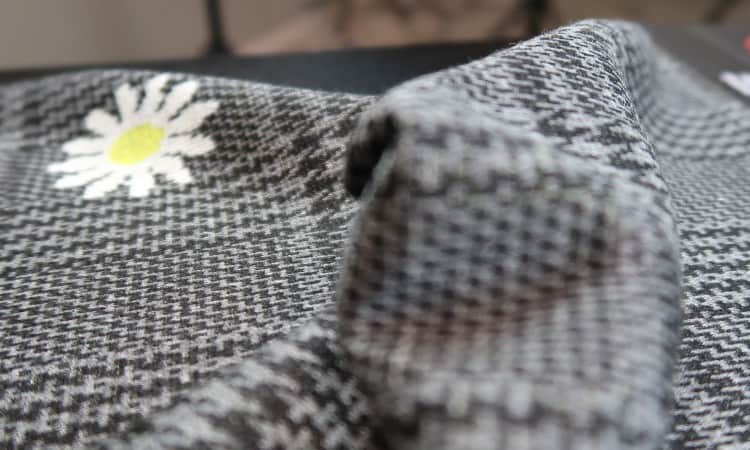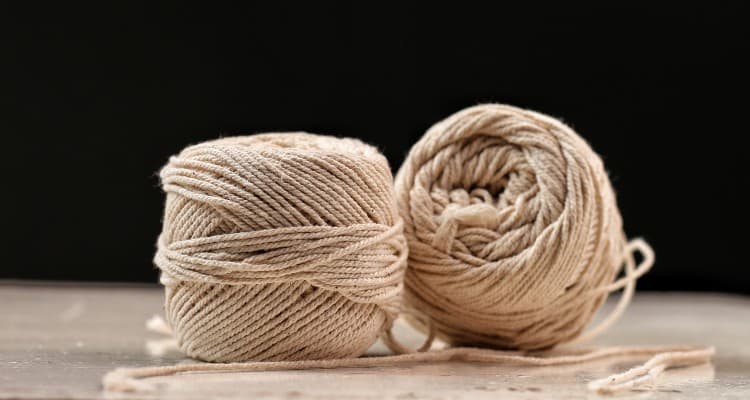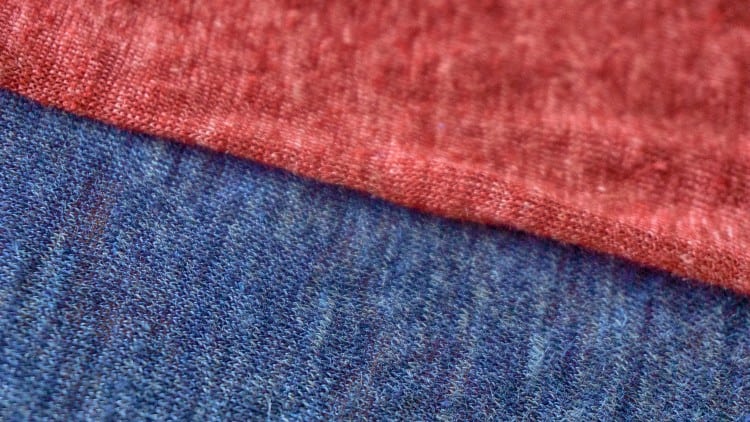Interlock knit fabric is a popular fabric choice for sewing because it can be used for many different types of clothing. The characteristics of interlock fabric are ideal for sewing due to the way the fabric is constructed. But what exactly is interlock knit fabric and how does it differ from other types of knit fabrics?
Interlock fabric is a type of double knit fabric. This type of knit results in thicker, stronger, stretchy, and more durable fabric than other types of knit fabric. Even with these qualities, it is still a very affordable fabric.
If you’re still unsure if interlock fabric is a good choice for your project, this article will explore the characteristics of interlock fabric and some of the most common types of clothing that it is used for. We will also look at the difference between interlock and other types of knit fabric, particularly jersey. Continue reading to learn more.

What Is Interlock Knit Fabric?
Interlock knit fabric is a variation of rib knit. Rib knit is a type of fabric knitted with rows that alternate between being raised and lowered. But instead of having just one row of stitches, interlock knit fabric has two rows of stitches.
The rows of stitches are created one behind the other, using two rows of needles that cross over each other to construct it. Because of the two rows, interlock knit fabric is known as a double knit fabric. The rows become “interlocked” as the fabric is knitted. The interlocked, double rows also create a fabric that is thicker than regular knit fabric.
While the construction of interlock fabrics makes the fabric feel very firm, it also has a soft and smooth texture. The thickness of the fabric makes it very absorbent as well. Overall, interlock knit fabric is very comfortable and can be used for a variety of things.
What Is Interlock Knit Fabric Made Of?

Interlock fabric can be made out of both natural and synthetic fibers. Still, to give it the most optimal characteristics, such as breathability and softness, natural fibers are preferred. Some of the most common natural fibers to make interlock are cotton, silk, and wool. You can also find interlock fabric made of polyester, rayon, and modal, but these aren’t as common as wool and cotton.
Wool interlock results in a very warm and ideal fabric for winter, but cotton is the most popular choice for interlock knit fabrics. This is because cotton is so versatile and can be used for a wide range of clothing options.
100% cotton is an eco-friendly fabric choice for interlock knit fabric. Cotton is soft, comfortable, breathable, and has a certain level of stretch to it. It is usually used for summertime clothing, but cotton can also be brushed to give it a warmer quality. This means that interlock knits made of cotton can be used to make both warm-weather and cold-weather clothing.
What Is Interlock Fabric Used For?
Due to the characteristics of interlock knit fabric, it can be used for many different types of clothing. The fabric is ideal for all temperatures and can be used to make casual or more formal clothing. Absorbency, thickness, comfort, and softness are factors in determining what interlock knit fabric is used for.
 Here are some of the most common uses:
Here are some of the most common uses:
- T-shirts
- Underwear
- Sportswear
- Pajamas
- Hoodies
- Baby clothes
- Dresses
Interlock knit fabric is a popular choice for underwear and pajamas due to its breathability. It is used for baby clothing due to its softness, hoodies due to its warmth, and t-shirts and dresses due to its comfort. The absorbency, breathability, and natural stretch also make interlock knit one of the best fabric choices for sportswear.
Benefits of Interlock Knit
 We’ve already covered all of the useful qualities that interlock knit fabric has for finished clothing. But for those who are deciding whether or not to use it for their own sewing projects, many benefits of interlock fabric make it easy to sew with it as well.
We’ve already covered all of the useful qualities that interlock knit fabric has for finished clothing. But for those who are deciding whether or not to use it for their own sewing projects, many benefits of interlock fabric make it easy to sew with it as well.
Some of the benefits of interlock fabric with regard to sewing are that interlock fabric:
- It is thicker than other fabrics
- It has a smooth surface
- It doesn’t curl like other knit fabrics
- Is flexible compared to other fabrics
- It looks the same on both sides
Overall, interlock knit fabric is very easy to work with. It is also very affordable, making it a great fabric option that can be used for almost any sewing project you can think of.
Is Interlock Knit Fabric Stretchy?
Due to the way it is constructed, interlock fabric is naturally stretchy, especially compared to regular jersey knit fabric. When the fabric is stretched, it will return to its original shape easily and retain its shape after being worn and washed repeatedly.
Other knit fabrics may curl when they are stretched, but interlock fabric won’t. This is because the two knitted rows are held together by a single thread. In addition to being stretchy, the fabric is also very sturdy and doesn’t tear or fray when stretched.
Although 100% cotton interlock fabric is naturally stretchy, sometimes it is blended with a small percent of spandex or lycra to make it a little more stretchy. This is usually necessary for activewear or underwear that needs to stretch more for added mobility. If it is a cotton/spandex/lycra blend, it is usually 95% cotton and 5% spandex/lycra.
What Is The Difference Between Jersey Knit And Interlock Knit?

Jersey and interlock are both knit fabrics that are commonly made from cotton, but they are not the same. There are quite a few differences between the two, in both appearance and fabric qualities. While interlock fabric is double knit, jersey is not. These different knit types account for the differences between the two fabrics.
Interlock knit fabric has the same texture on both sides because of the double knit pattern. This means that you will see the same pattern on both sides of the fabric. With jersey fabric, only one side of the fabric is smooth. Unlike jersey fabric, when sewing with interlock fabric, it doesn’t matter which side faces out.
Interlock knit fabric is also thicker than jersey knit. The thicker knit means that it is not only more durable but also warmer than jersey fabric. Interlock fabric can be used for a wider variety of sewing projects.
The thicker, double knit also makes interlock fabric more stable than a jersey, meaning that the fabric will retain its shape better when it is stretched or worn and washed frequently. Jersey fabric tends to curl up when it is stretched, and it doesn’t return to its original shape as readily as interlock fabric.
Jersey fabric is somewhat stretchy, but it is not as stretchy as interlock. You are likely to find jersey fabric blended with a higher percentage of spandex/lycra to increase stretching, especially when used for athletic wear such as leggings.
Jersey is also knitted to have only one layer of fabric, while interlock has two layers. This results in interlock being heavier and more firm. This is why interlock fabric can be used for a wider variety of clothing. It is also a better choice for heavier clothing items, such as hoodies and some winter clothing.
How Do I Know If My Fabric Has Interlock?
It is fairly easy to tell the difference between interlock fabric and other fabrics that aren’t knitted. However, suppose you’re trying to differentiate between jersey and interlock knit fabric. In that case, it can be difficult to tell the difference unless you have a fabric sample of both types to compare them.
There are two main ways that can help you tell the difference between interlock and jersey fabric. If you have a piece of fabric of both types, the first way is to look at the knitting pattern. Jersey fabric will show the knitted texture on only one side, so you can tell that it is only a single layer of fabric. Interlock fabric will show the knitted texture on both sides.
Let’s say you have a piece of knit fabric, but you are unsure if it is interlock or jersey. If you don’t have a sample of a different type of knit fabric for comparison, the easiest way to tell is to gently stretch it. If the fabric has interlock, the edges will not curl when you stretch it but will lay flat instead. Jersey fabric will curl around the edges when it is stretched.
How To Care For Interlock Knits Fabric
 Since most interlock fabric is made of cotton, it can shrink when it is washed. Before you start a sewing project using interlock knit, you should pre-wash it so that you know what state it will be in before you use it. This will allow the most shrinkage to happen before you use it, instead of after your project is finished and you find that it doesn’t fit as it should.
Since most interlock fabric is made of cotton, it can shrink when it is washed. Before you start a sewing project using interlock knit, you should pre-wash it so that you know what state it will be in before you use it. This will allow the most shrinkage to happen before you use it, instead of after your project is finished and you find that it doesn’t fit as it should.
Hot water can shrink cotton fabric, so whether the fabric is knit or not, you should wash it in cold water to prevent shrinking. With knit fabrics, it is best to wash them on the gentle cycle. When it is time to dry it, you can put it in the dryer, but it should dry on low heat to prevent further shrinking. Washing cotton knit fabrics this way every time is the best way to keep them in good shape.
Other types of interlock fabric may require different care depending on fabric type. For example, the fibers of wool interlock fabric are more delicate than cotton, so they must be washed a little differently. Wool should be turned inside out if possible. Wash it in the washing machine on the gentle cycle using cold water, or hand wash it. Wool is also easily damaged by heat, so it should be hung up to dry instead of being placed in the dryer.
Washing your fabrics the correct way is important for keeping them in good shape and prolonging the life of them. If you are using interlock fabric made of a material other than cotton and wool, this guide provides recommendations for washing each fabric type.
Conclusion
We hope this article provided you with a better understanding of what interlock fabric is. Interlock fabric differs from other types of knit fabric because it is typically thicker, more firm, and retains its shape after being stretched. This is why it is such a popular fabric choice for a wide variety of fabrics. If you enjoyed this article and found it helpful, leave a comment and share it with others. Thanks for reading!